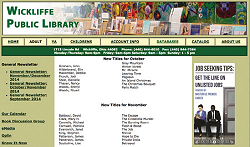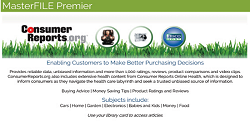 |
| This promo image shows users how a library can help without even saying “database.” |
 |
| Signs like this can lead searchers from your stacks straight to your databases. |
 | | Wickliffe (Ohio) Public Library’s website promotes “job seeking tips” rather than a name of a database. The picture links to a page where people enter their library card numbers, and they’re taken directly to the article. This eliminates the need for patrons to search. |
 |
| The front of this flier promotes content that's found in Consumer Reports. Cheat notes on the back, shown here, make it easy for staffers to know enough to help patrons. |
Thanksgiving dinner was fabulous this year. Then sometime between the turkey and the desserts, my family members began to talk about the latest books we were all reading. My oldest sister, a member of two book clubs and an avid reader, had a long list of favorites. I mentioned that my husband and I were listening to Unbroken on the trip up north when my other sister scoffed at the cost of audiobooks. “But you can get them free from your library,” I said.
Predictably, everyone was amazed that libraries offer downloadable audiobooks. It was predictable because we have the same conversation every year, and they always seem surprised that the library offers something of value for them. This year, it was audiobooks. In the past, I’ve told them that libraries have ebooks, large-print books, text-a-librarian services, yoga tapes, live author programs, magazines—the list goes on and on. It gets frustrating to have these Groundhog Day conversations every year, but the fact is, my family is not unusual.
The latest findings from the The Pew Research Center’s Internet & American Life Project (www.tinyurl.com/qb5bkp4) confirm that while most people say they like their library and feel it is important to their communities, 77% say they know either some, not much, or nothing of what those libraries offer. That’s a little scary.
It doesn’t have to be this way. During my time as the marketing director at the New Jersey State Library, and now as I work on developing a professional marketing-communication product, I’ve learned how important it is to reach people with the right message, at the right time, through the channels they’re already using. This is especially true when it comes to your online resources.
The databases that you pay so much for provide an amazing array of articles with a depth of info that doesn’t show up in the public’s G oogle searches. One challenge of promoting databases is that using them often requires patrons to take the extra step of entering their identification numbers before viewing the content. Another is that they’re simply not as visible as books on shelves. To overcome these challenges, I’ll share five strategies to help you introduce people to the relevant and interesting content that awaits them.
Strategy 1: Use Eye-Catching Images
In today’s online world, visual content is a requirement, not a luxury. The brain processes images faster than words. Plus, images are easily shareable, and they express ideas quickly. So keep in mind that people see images first, then captions, then headlines, then copy. (The only exception might be if the headline is designed to be the strongest element.) Oh, and you only have about 3 seconds to catch the attention of your readers.
So concentrate on creating strong headlines and compelling images and employ very little copy. One way to practice is to create a promotion without any words and see if the image is conveying what you need it to communicate. Then do the same thing with a headline.
Strategy 2: Promote by Content, Not by Name
Traditionally, librarians have tried to promote databases as products rather than promoting the helpful content within them. This just doesn’t make sense. So concentrate on promoting the content and the benefit that a database will bring to those who use it.
Williamsburg (Va.) Regional Library did an excellent job using this strategy when it promoted its auto repair database (see photo above). By combining five words with an “action” graphic, the library was able to clearly convey a solution for its patrons.
In order to know what your patrons want and need, you must first identify a group of people with similar needs or interests. When it comes to marketing your databases, it’s always better to start small. For example, you might choose to address the needs of people who are changing jobs, learning a new skill set, facing a health issue, or writing a report for school. Once you’ve identified a group, take a few minutes to list some challenges the members are facing and then select those databases that offer solutions.
Strategy 3: Cross-Promote Next to Related Resources
An easy way to start cross-promoting is to select a few programs you’ve already planned and look at the resources you have that are relevant to them.
This sample job-seeker graphic with a QR code (above) would be helpful for anyone who’s looking for work, so it makes sense to put it wherever related books and magazines are located. Consider adding this type of signage to your tabletop displays. (While there are many pros and cons to QR codes, using them to help people connect to online resources can be effective.)
Another easy strategy is to cross-promote your databases in your stacks. Use “shelf talkers” to remind people of your online content. Shelf talkers are small signs that most libraries use to help browsers find read-alikes. But there’s no reason why you can’t use this valuable shelf space to cross-promote your databases. The key is to keep the content relevant for browsers so there is a logical connection.
Strategy 4: Promote Across Communication Channels
It is important to make sure you are communicating through all of your available channels. That means using your webpages, social media, email, and in-house spots. Here’s how:
- When posting to your webpages or social media sites, make it easy for your customers to access a database by providing a link either directly to the article, to the search box, or to the access page.
- If your library has created Pinterest boards, consider promoting your databases according to topics rather than creating a board specifically for all databases.
- Add rich content to your emails with promotions that link to topic-appropriate articles or searches.
I found a great example of this at the Salt Lake City Public Library System. It cross-promoted www.lynda.com on its website, Facebook page, and Pinterest page and used lynda.com’s unique logo in each place. (In those rare cases in which an online resource is being offered to both the public and libraries, as lynda.com is, it’s effective to leverage the company’s marketing by using the name and logo.)
Posting timely content to Twitter is another fantastic way to promote content. F or example, in January you might consider posting links to articles that will help patrons stick to common New Year’s resolutions such as losing weight, saving money, or getting organized.
Strategy 5: Educate Your Staff
Don’t assume that everyone on your staff knows what each database does and why it’s valuable to users. If you encourage reference experts to teach other staffers about these premium resources, everyone will be better equipped to point patrons to them. H ere are some ideas:
- Via all-staff emails, list and highlight one database each month and explain ways patrons might use it.
- Include “cheat notes” on the backs of your fliers (see image above) to enable staff members to educate themselves at the point of demand rather than having to memorize every database.
- Engage employees by having them conduct searches on topics and post links online. The more they use databases, the more they’ll be excited about the content, and the more they’ll want to share with patrons.
Increase Usage and Raise ROI
Databases enable you to offer rich content that can help solve many of the problems your patrons are facing. By using some or all of these five strategies, you can effectively drive database usage and get your money’s worth from them.
|